Green birds are a common sight in Florida, with several species of the avian group found in the region. These birds are recognized for their distinctive green plumage, which is often accompanied by various shades of yellow, blue, and red.
Apart from their striking appearance, green birds are also known for their melodic songs, with some species considered to be among the most vocal of all bird groups.
Additionally, many green bird species are adaptable and can thrive in a variety of habitats, from wetlands to urban areas.
This article will explore the various types of green birds found in Florida and provide interesting facts about each of them.
1. Rose-Ringed Parakeet
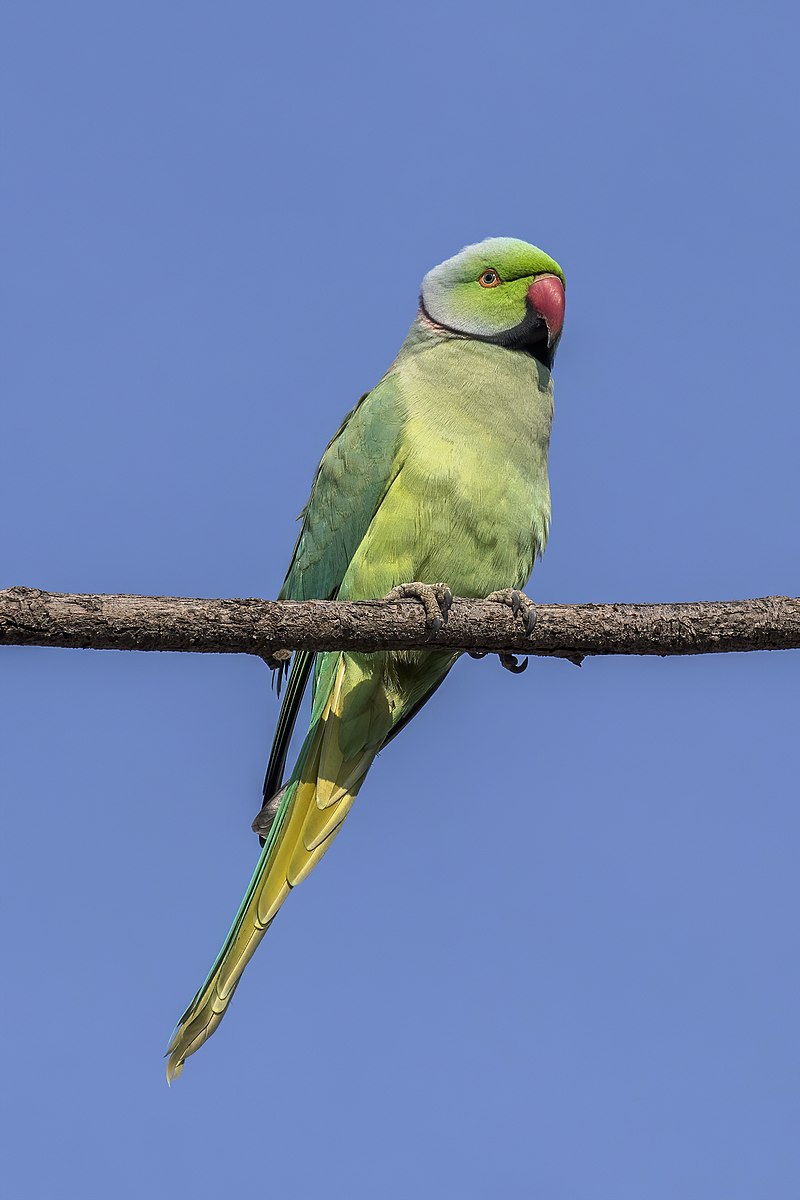
The Rose-ringed parakeet is a medium sized bird in the family Psittacidae. Native to Africa and India, it has been introduced into many other parts of the world where feral populations have now established themselves.
The most distinctive feature of this species is its colorful neck ring ranging from pink to purple which gives them their name.
However, males often display more vibrant colors than females do. This beautiful bird can also imitate human speech quite well making them popular pets worldwide.
In addition they are very social creatures preferring large flocks when out in nature or as part of aviaries during captivity. With proper care these birds can live up to 30 years.Scientific classification:
| Kingdom | Animalia |
| Phylum | Chordata |
| Class | Aves |
| Order | Psittaciformes |
| Family | Psittaculidae |
| Genus | Psittacula |
| Species | P. krameri |
Also Featured In: Common Birds in India, Common Birds in the Cities
2. American Wigeon
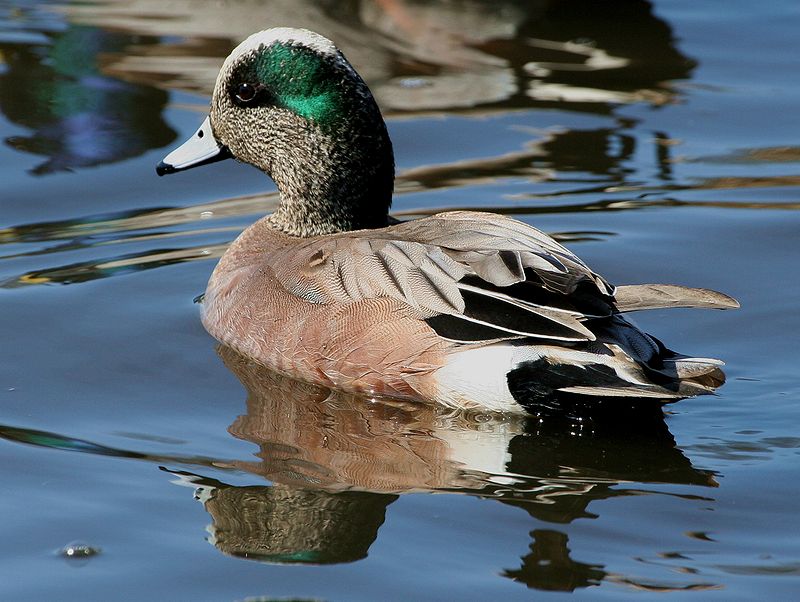
The American Wigeon, also known as the Baldpate, is a species of dabbling duck found throughout North America.
It closely resembles its Eurasian counterpart and was formally described in 1789 by German naturalist Johann Friedrich Gmelin.
This medium-sized bird has an overall grey body with white feathers on its face and belly that give it a distinctive bald appearance.
Its wings are brownish black with green speculum markings on them while the tail is dark brown or black at the base and gradually lightens near tips to become chestnut colored.
The male wigeons have purple patches on their heads during breeding season along with yellow eyes which helps differentiate them from females who have duller colors around their faces instead of bright ones like males possess.Scientific classification:
| Kingdom | Animalia |
| Phylum | Chordata |
| Class | Aves |
| Order | Anseriformes |
| Family | Anatidae |
| Genus | Mareca |
| Species | M. americana |
Also Featured In: Most Popular Bird Species in North America, British Columbian Birds
3. Mallard
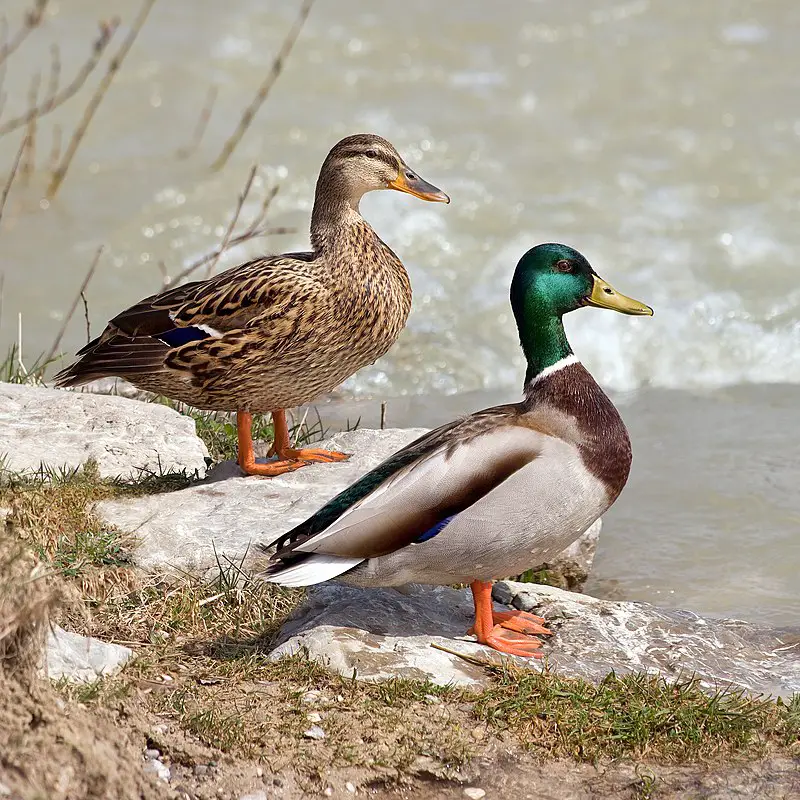
The Mallard is a species of dabbling duck that can be found living in temperate and subtropical regions across the Americas, Eurasia and North Africa.
It has been introduced to other areas such as New Zealand, Australia, Peru, Brazil and South Africa by humans.
This beautiful bird belongs to the Anatinae subfamily of waterfowl family Anatidae. The adult mallards have a glossy green head with white neck ring surrounding.
It along with brownish grey body feathers making them look stunning when they fly away or just sitting in their natural habitat around lakes or ponds.
They are excellent swimmers too due to webbed feet which helps them swim fast underwater while looking for food like aquatic insects etc.. Their loud quacking sound makes them quite popular among nature lovers.Scientific classification:
| Kingdom | Animalia |
| Phylum | Chordata |
| Class | Aves |
| Order | Anseriformes |
| Family | Anatidae |
| Genus | Anas |
| Species | A. platyrhynchos |
Also Featured In: Most Common Lake Birds, Most Common Nature Birds
4. Green Heron
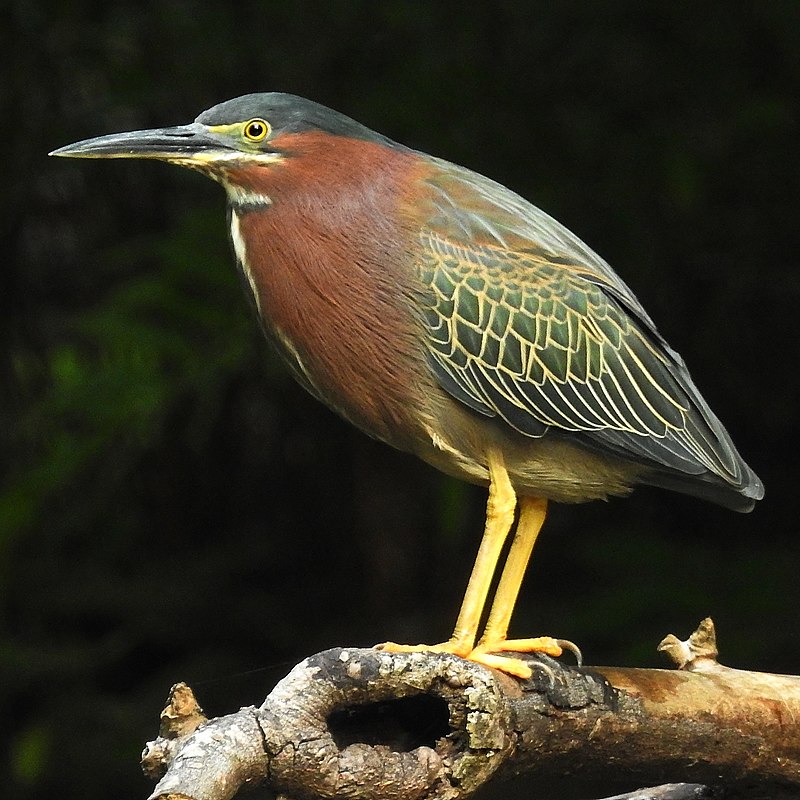
The Green Heron (Butorides virescens) is a small heron found throughout North and Central America.
It’s scientific name comes from Middle English ‘butor’ meaning bittern, combined with the Latin term for its distinctive greenish color – ‘virescens’.
For many years it was considered to be part of the same species as the Striated Heron (Butorides striata), commonly referred to as “green-backed herons”.
The nominate subspecies inhabits wetlands across much of this range, where they can be spotted stalking about in shallow water looking for fish or frogs on which to feed.
They are fascinating wading birds that have even been known to use tools such as sticks or baited lines when fishing.Scientific classification:
| Kingdom | Animalia |
| Phylum | Chordata |
| Class | Aves |
| Order | Pelecaniformes |
| Family | Ardeidae |
| Genus | Butorides |
| Species | B. virescens |
Also Featured In: Top Birds Found in Mexico, Common Southern Californian Birds
5. Smooth-Billed Ani
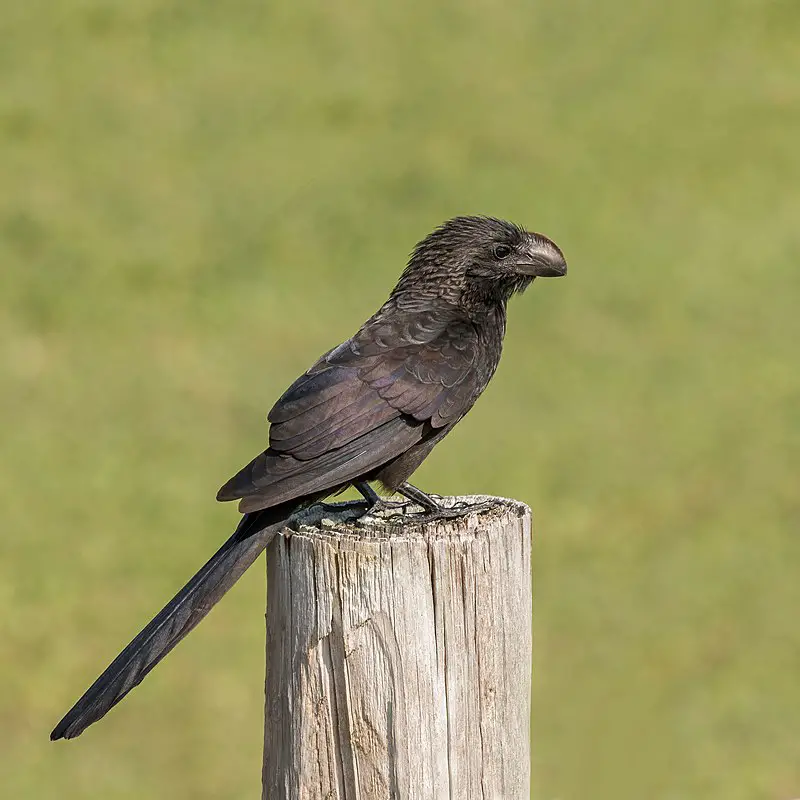
The Smooth-billed Ani is a species of bird in the cuckoo family, native to regions spanning from southern Florida and the Caribbean down through Central America, South America, and parts of Argentina.
They have even been introduced to Galapagos around 1960s where they may be impacting local wildlife due to their aggressive nature.
As its name suggests, these birds have smooth bills which are adapted for feeding on hard fruits or other items such as insects and lizards that it finds while scavenging around trees or ground level vegetation.
They usually form small flocks when out searching for food with males being slightly larger than females.
Overall this adaptable species is found in many habitats across its broad range but does best at low elevation open areas near water sources like marshes or swamps making them easier targets for human disturbance as well.Scientific classification:
| Kingdom | Animalia |
| Phylum | Chordata |
| Class | Aves |
| Order | Cuculiformes |
| Family | Cuculidae |
| Genus | Crotophaga |
| Species | C. ani |
Also Featured In: Common Birds in Colombia, Birds that You’ll Find in Puerto Rico
6. Common Goldeneye
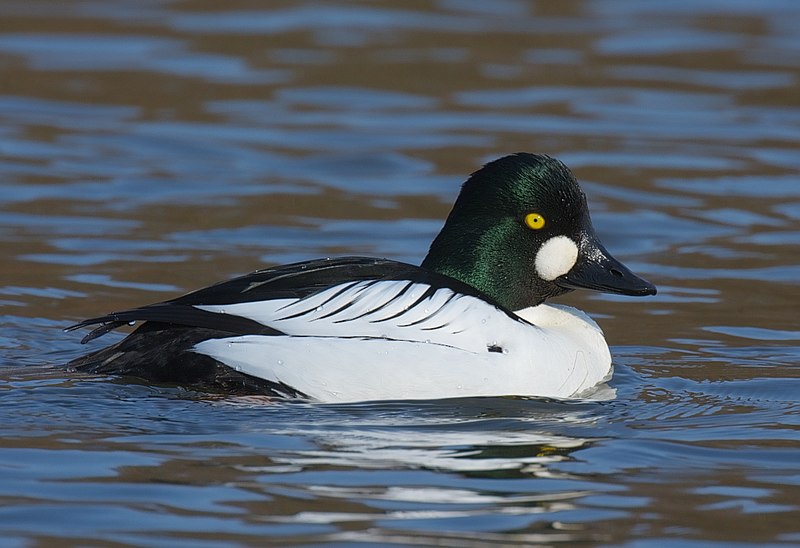
The Common Goldeneye is a medium-sized sea duck from the genus Bucephala. It has an iconic golden eye and bulbous head, which gave it its scientific name – Boukephalos (bullheaded).
This species can be found in many areas of North America, Europe and Asia. They are usually seen swimming alone or in pairs near large bodies of open water such as lakes and rivers.
In addition to their distinctive eyes, they have white wing patches on either side with black spots along the edges – helping them stand out among other ducks.
The diet of these birds includes aquatic insects, mollusks and crustaceans.
During mating season males often perform elaborate courtship displays including head bobbing while producing loud calls that can travel quite far distances across the landscape.Scientific classification:
| Kingdom | Animalia |
| Phylum | Chordata |
| Class | Aves |
| Order | Anseriformes |
| Family | Anatidae |
| Genus | Bucephala |
| Species | B. clangula |
Also Featured In: Birds of Poland, Black And White Birds You Don’t Know About
7. Western Swamphen
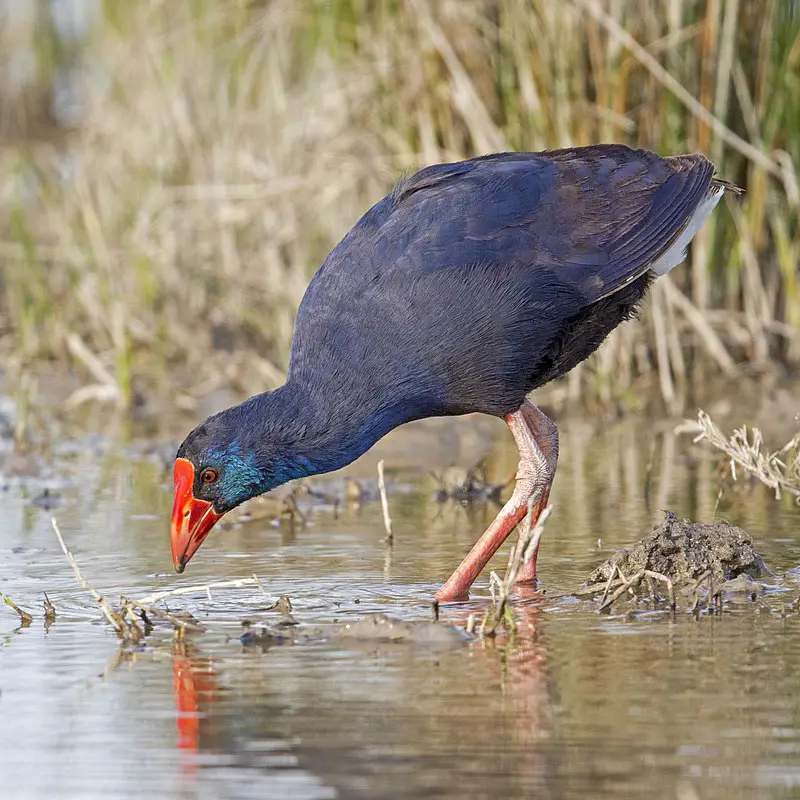
The Western Swamphen is a species of swamphen belonging to the Rallidae family. It has an impressive appearance: its bright plumage, long legs and large red bill make it easily recognizable.
Its French name ‘talève sultane’ gives it the nickname of ‘Sultana Bird’. It is typically chicken-sized but can be slightly larger in some areas.
The Western Swamphen’s diet consists mainly of aquatic vegetation such as pondweeds, watercress and rushes, along with small invertebrates like snails, insects and larvae.
Breeding usually occurs between spring and summer when mating pairs construct nests made from reed stems near shallow waters or marshlands which they defend fiercely against intruders.
The male also performs courtship displays by raising his feathers while bobbing up and down in front of potential mates to attract them into their territories for breeding purposes.Scientific classification:
| Kingdom | Animalia |
| Phylum | Chordata |
| Class | Aves |
| Order | Gruiformes |
| Family | Rallidae |
| Genus | Porphyrio |
| Species | P. porphyrio |
Also Featured In: Birds of Morocco, Common Birds of Portugal
8. Budgerigar
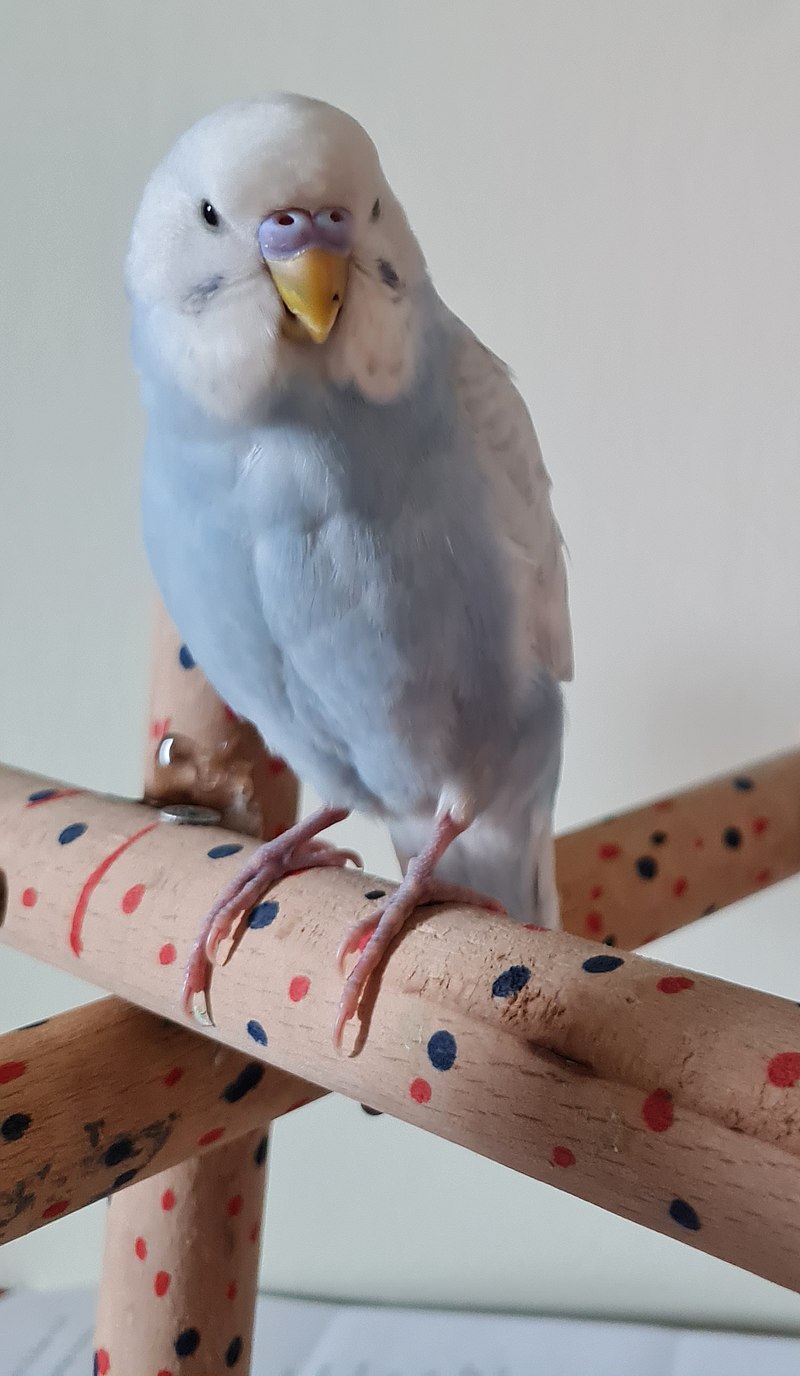
The Budgerigar is a small and beautiful parrot, commonly known as the common parakeet or shell parakeet. It has an average length of 18 cm with a long tail and primarily green-yellow coloration along its body.
Black stripes can be found on their wings and cheeks while they have white rings around their eyes giving them a unique look.
These birds are mainly seed eaters but also love fruits, vegetables, nuts and other grains in captivity.
They are highly social creatures that live in large flocks in the wild but enjoy companionship when kept as pets too.
Their ability to mimic human speech makes them great conversation partners for those living alone who need some company.Scientific classification:
| Kingdom | Animalia |
| Phylum | Chordata |
| Class | Aves |
| Order | Psittaciformes |
| Family | Psittaculidae |
| Subfamily | Loriinae |
| Tribe | Melopsittacini |
| Genus | Melopsittacus Gould, 1840 |
| Species | M. undulatus |
Also Featured In: Most common birds in Australia, Aviary Birds You Should Know
9. Buff-Bellied Hummingbird
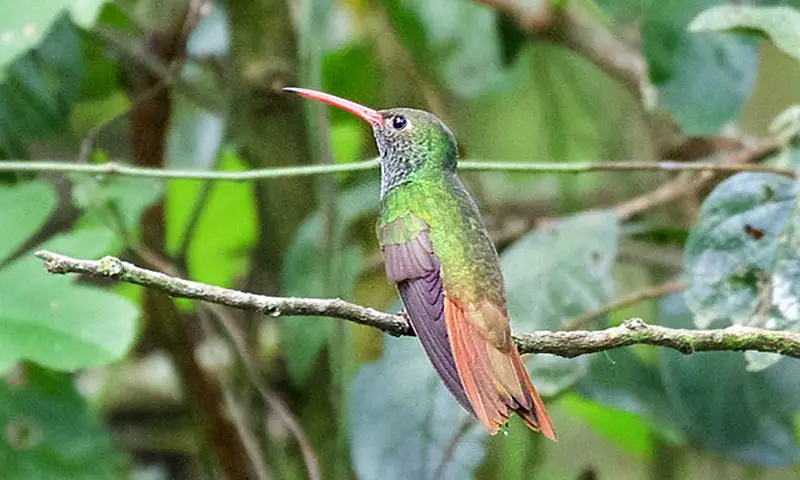
The Buff-bellied Hummingbird is a species of hummingbird belonging to the Trochilini tribe and found in Central America and parts of the United States.
It has three subspecies: A. y. yucatanensis, A. y chalconota, and A.y cerviniventris whose length ranges from 3.9 – 4 inches (10 – 11 cm).
The buff-bellied hummingbird’s plumage is mainly grey with greenish reflections on its back while it sports a distinctive buff colored belly which gives this species its name.
Its diet consists mostly of nectar as well as small insects; they often feed upon flowers near rivers or other bodies of water where their preferred food sources are plentiful.
In addition to being quite beautiful birds, these delightful creatures also possess an impressive ability for hovering flight making them one of nature’s most graceful avian wonders.Scientific classification:
| Kingdom | Animalia |
| Phylum | Chordata |
| Class | Aves |
| Order | Apodiformes |
| Family | Trochilidae |
| Genus | Amazilia |
| Species | A. yucatanensis |
Also Featured In: Most Beautiful Birds in Guatemala, Red Birds You’ll Commonly Found in Texas
10. Red-Lored Amazon
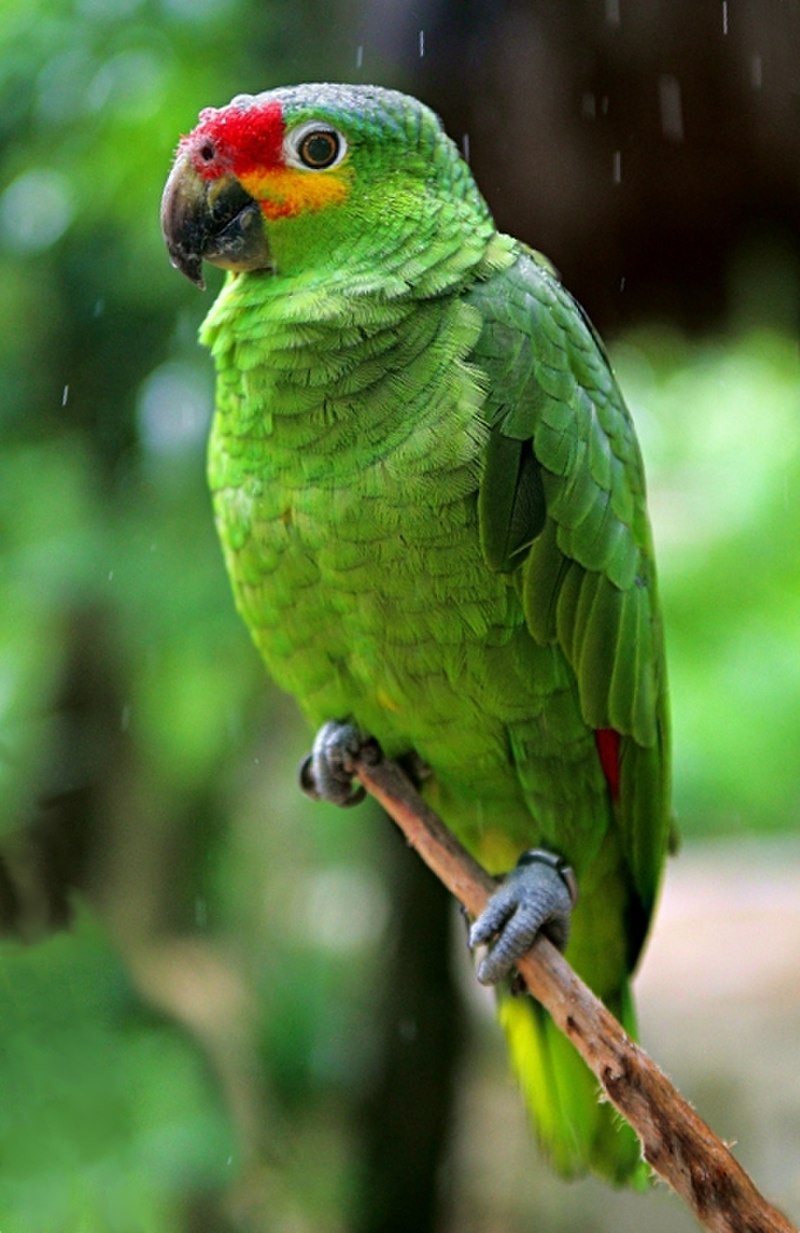
The Red-lored Amazon is a brightly coloured parrot native to tropical regions of the Americas, from eastern Mexico south to Ecuador. It inhabits humid evergreen and semi-deciduous forests up to 1,100 metres above sea level.
This species was not originally known in El Salvador but there have been reports of escaped birds seen in this region recently.
The Red-lored Amazon has an overall green plumage with red on its forehead that extends down onto its cheeks and throat while its belly is yellowish or orangey in colouration.
They are also well known for their intelligence and ability to mimic human speech which make them popular as pets.
However, they are listed under CITES Appendix II due largely because deforestation continues at an alarming rate throughout much of their range within Central America causing population declines across many areas where these birds occur naturallyScientific classification:
| Kingdom | Animalia |
| Phylum | Chordata |
| Class | Aves |
| Order | Psittaciformes |
| Family | Psittacidae |
| Genus | Amazona |
| Species | A. autumnalis |
Also Featured In: Birds of Ecuador,
11. Blue-Crowned Parakeet
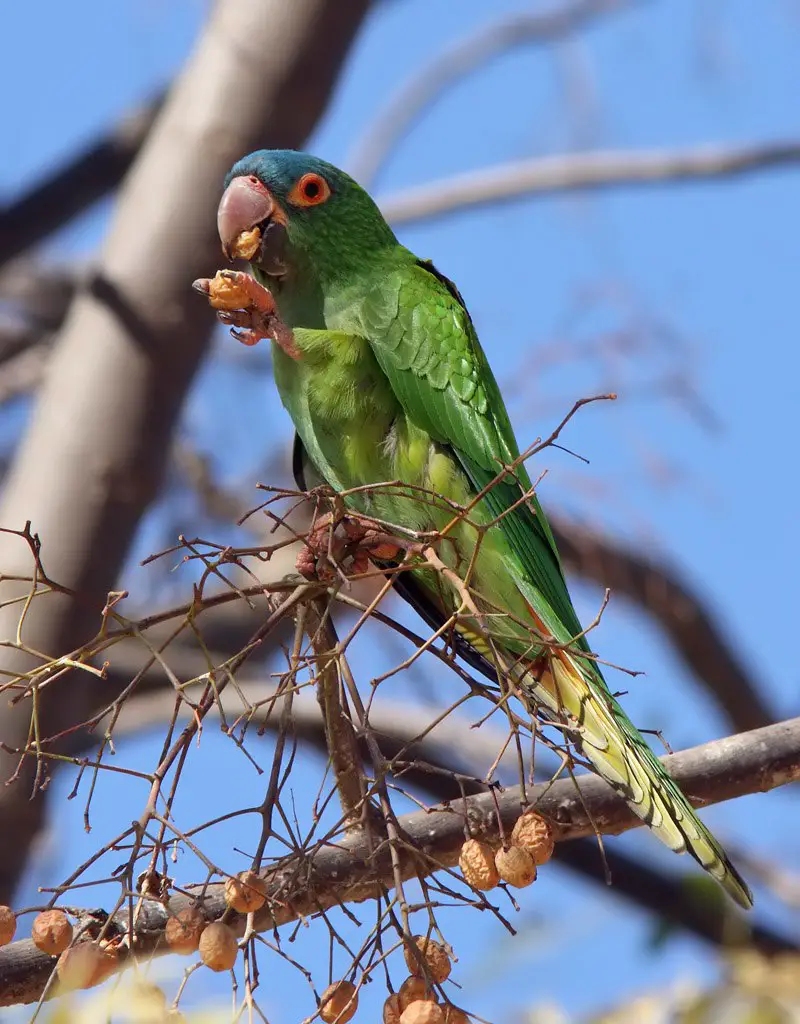
The Blue-crowned parakeet is a small, green Neotropical bird native to South America. It has a blue head and pale beak with sharp tail feathers that set it apart from other species of parrots.
They are commonly found in savanna-like habitats, woodland edges, and open forest areas but avoid dense humid forests like the Amazon rainforest.
This species feeds primarily on fruits and nuts as well as some insects such as grubs or caterpillars at times.
The Blue-crowned Parakeet pairs for life and will raise their young in flocks known as crèches which consist of both parents taking care of multiple clutches at once.
These birds make wonderful pets if properly socialized because they can learn to mimic human speech quite easily while also being very affectionate companions.Scientific classification:
| Kingdom | Animalia |
| Phylum | Chordata |
| Class | Aves |
| Order | Psittaciformes |
| Family | Psittacidae |
| Tribe | Arini |
| Genus | Thectocercus Ridgway, 1912 |
| Species | T. acuticaudatus |
Also Featured In: Birds of Bolivia,
12. Cuban Emerald
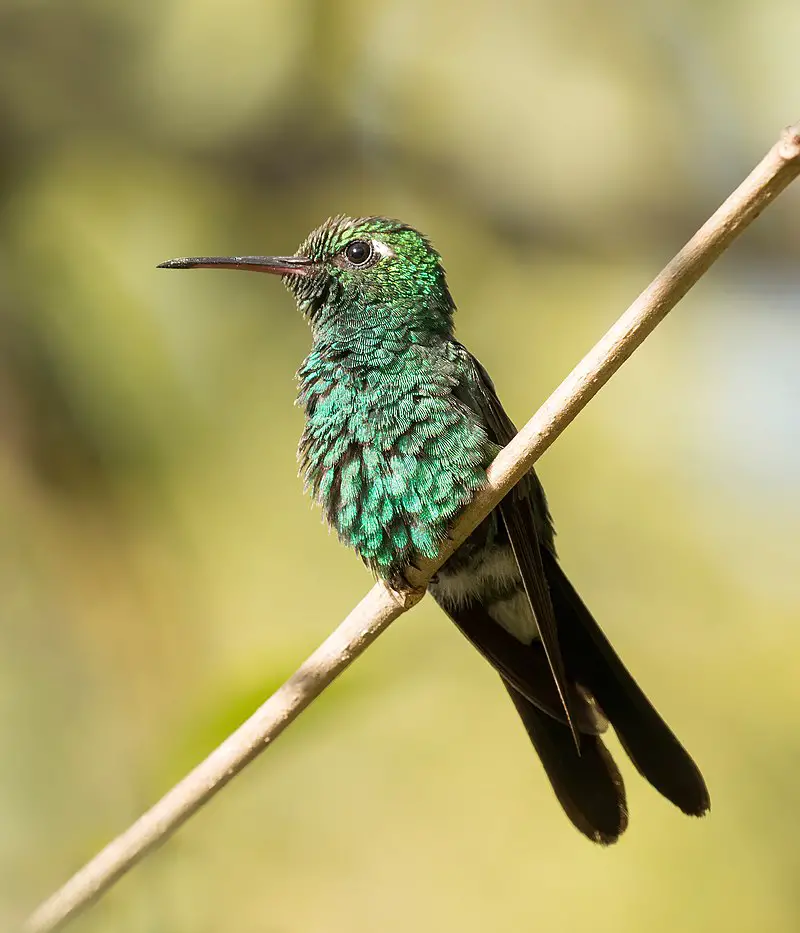
The Cuban Emerald is a species of hummingbird found in the Bahamas and Cuba. It belongs to the Trochilini tribe, which are known as ’emeralds’.
This bird was formerly placed in the genus Chlorostilbon but recent studies have shown that it actually belonged with other emeralds.
The body of this small bird is predominantly green-colored with an iridescent blue throat patch on its chin and some purple or bronze feathers towards its tail end.
Its diet consists mainly of nectar from various flowers, although insects also form part of their daily sustenance.
They use their long curved beaks to reach deep into tubular flowers for nectar, while hovering mid-air like tiny helicopters.
With no natural predators due to their quick maneuverability and powerful wings; these birds can fly up to speeds over 50 km/h.Scientific classification:
| Kingdom | Animalia |
| Phylum | Chordata |
| Class | Aves |
| Order | Apodiformes |
| Family | Trochilidae |
| Genus | Riccordia |
| Species | R. ricordii |
Also Featured In: Most Common Types of Birds Found in Cuba, Hummingbirds Live around Florida
13. Chestnut-Fronted Macaw
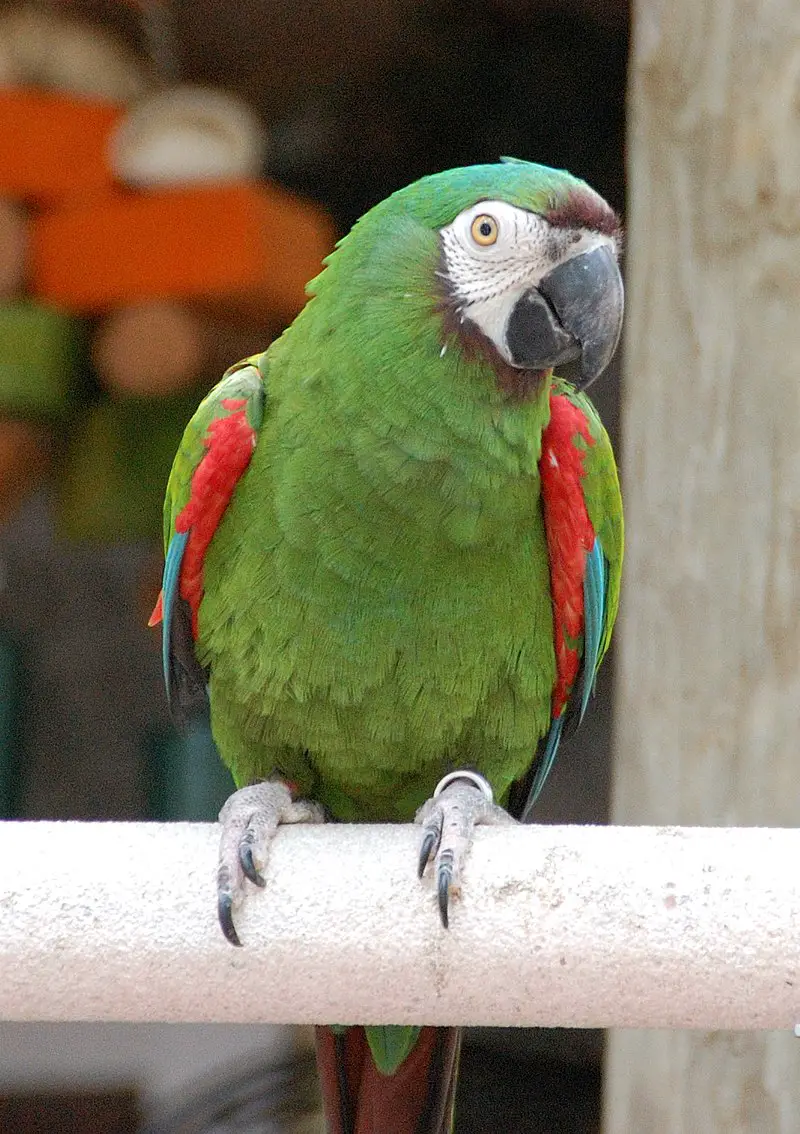
The Chestnut-fronted Macaw, also known as the Severe Macaw, is a mini-macaw species native to Northern South America.
They are considered one of the largest macaws and typically reach 18 inches in length with half of that being from their tail.
These beautiful birds can be found stretching from Panama down into Brazil and Bolivia while they have even established a feral population in Florida.
With an expected lifespan ranging anywhere between 30 to 50 years these exotic beauties make for quite endearing companions if properly taken care of.
For those looking for interesting conversation pieces or feathered friends this may just be your perfect choice.Scientific classification:
| Kingdom | Animalia |
| Phylum | Chordata |
| Class | Aves |
| Order | Psittaciformes |
| Family | Psittacidae |
| Genus | Ara |
| Species | A. severus |
Also Featured In: Panama Birds, Rainforest Birds You Should Know
14. Ruby-Throated Hummingbird

The ruby-throated hummingbird (Archilochus colubris) is a species of hummingbird that has an impressive migration pattern, spending the winter in Central America, Mexico and Florida before flying to Canada and other parts of Eastern North America for breeding season.
It’s by far the most common type seen east of the Mississippi River in North America.
Formally described by Swedish naturalist Carl Linnaeus in 1758, this tiny bird has bright metallic green upperparts with white underparts, a small black bill and a red throat patch which gives it its name; they measure around 3 inches long on average.
They feed primarily on nectar from flowers but also eat insects such as flies or mosquitoes for extra protein during their migrations or when raising young chicks.Scientific classification:
| Kingdom | Animalia |
| Phylum | Chordata |
| Class | Aves |
| Order | Apodiformes |
| Family | Trochilidae |
| Genus | Archilochus |
| Species | A. colubris |
Also Featured In: Georgia Birds, Birds Live in Arkansas
15. Ruby-Crowned Kinglet
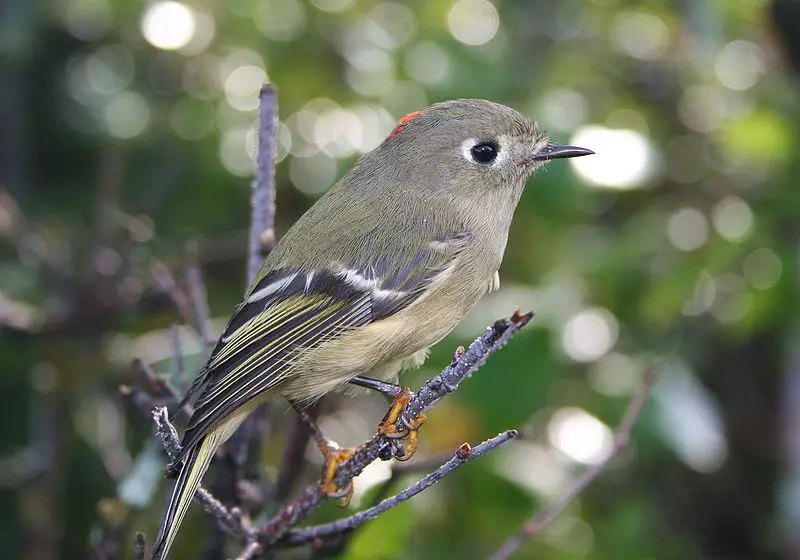
The Ruby-crowned Kinglet is a small passerine bird native to North America. It has olive green plumage, white wing bars and an eye-ring as well as a distinctive red crown patch on the males.
Juveniles look similar to adults with no distinguishing features other than size.
They are usually found in coniferous forests or woodlands where they spend much of their time searching for insects among foliage and branches while constantly flitting from place to place.
These birds have incredible energy levels that allow them to travel long distances during migration season without getting exhausted too quickly, making them one of nature’s most resilient species.Scientific classification:
| Kingdom | Animalia |
| Phylum | Chordata |
| Class | Aves |
| Order | Passeriformes |
| Family | Regulidae |
| Genus | Corthylio Cabanis, 1853 |
| Species | C. calendula |
Also Featured In: Central Texas Birds, Autumn Birds You Should Know
16. Hooded Warbler
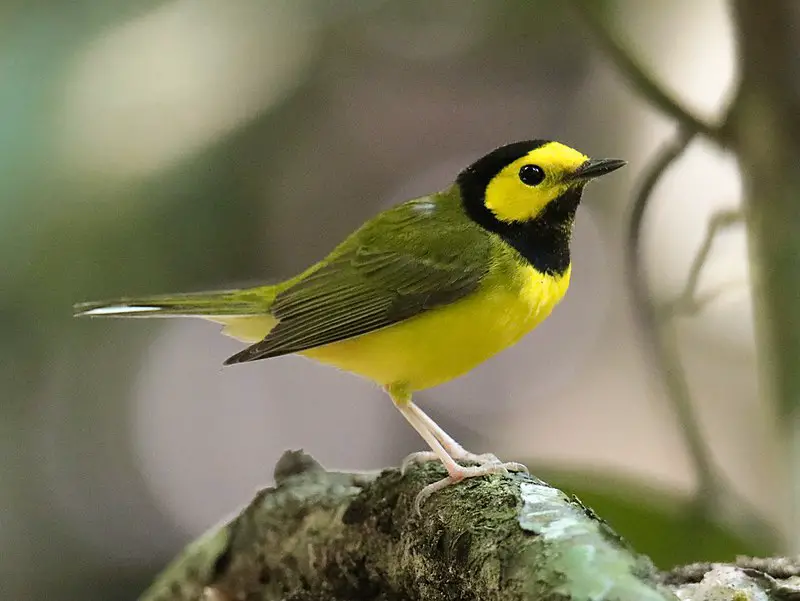
The Hooded Warbler is a species of New World warblers that breed in eastern North America and migrate to Central America and the West Indies for winter.
It has distinctive yellow, hood-like markings on its head which distinguish it from other similar looking birds.
Recent genetic research suggests that this bird was originally classified as Wilsonia citrina, making it one of the oldest known species discovered by scientists today.
The Hooded Warbler can be found near moist woodlands where they feed mainly on insects such as caterpillars and grasshoppers.
They have also been observed eating fruits including wild cherries during migration periods when food sources are scarce.
This unique little bird plays an important role in maintaining healthy ecosystems throughout their range; however climate change may pose serious threats to their survival if not addressed soon enough.Scientific classification:
| Kingdom | Animalia |
| Phylum | Chordata |
| Class | Aves |
| Order | Passeriformes |
| Family | Parulidae |
| Genus | Setophaga |
| Species | S. citrina |
Also Featured In: Birds that Live in Mississippi, Caribbean Birds
17. Orange-Winged Amazon
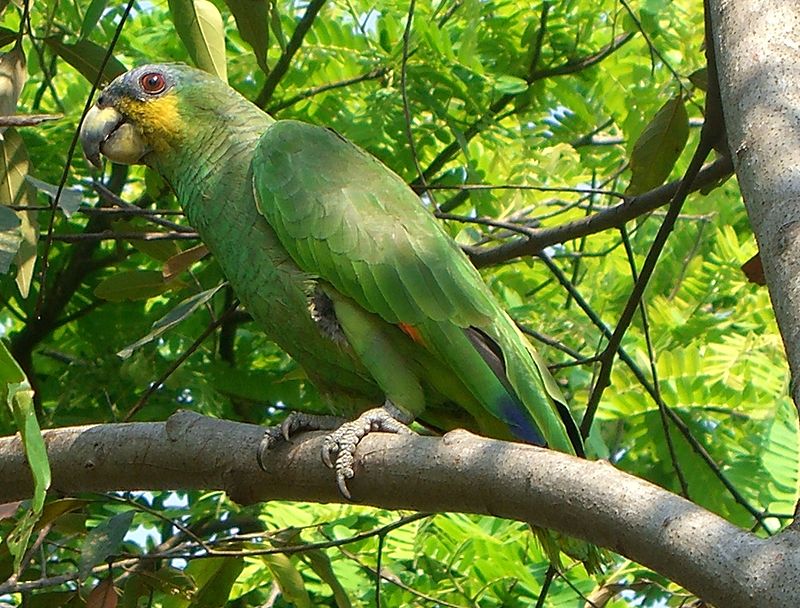
The orange-winged amazon is a vibrant and large parrot native to South America. Its habitat consists of both tropical forests and semi-open country areas, spanning from Colombia, Trinidad & Tobago down to Peru, Bolivia and central Brazil.
Although its population seems healthy at the moment due to its wide range throughout these countries, it still suffers persecution as an agricultural pest as well as capture for the pet trade industry.
It has striking features that make it easily distinguishable; namely bright red feathers on its forehead along with yellowish-orange wings which give this bird its name.
With proper protection against poaching and hunting by humans in place they should remain a colorful addition to our planet’s avian family.Scientific classification:
| Kingdom | Animalia |
| Phylum | Chordata |
| Class | Aves |
| Order | Psittaciformes |
| Family | Psittacidae |
| Genus | Amazona |
| Species | A. amazonica |
Also Featured In: Trinidad and Tobago birds,
18. Yellow-Headed Amazon
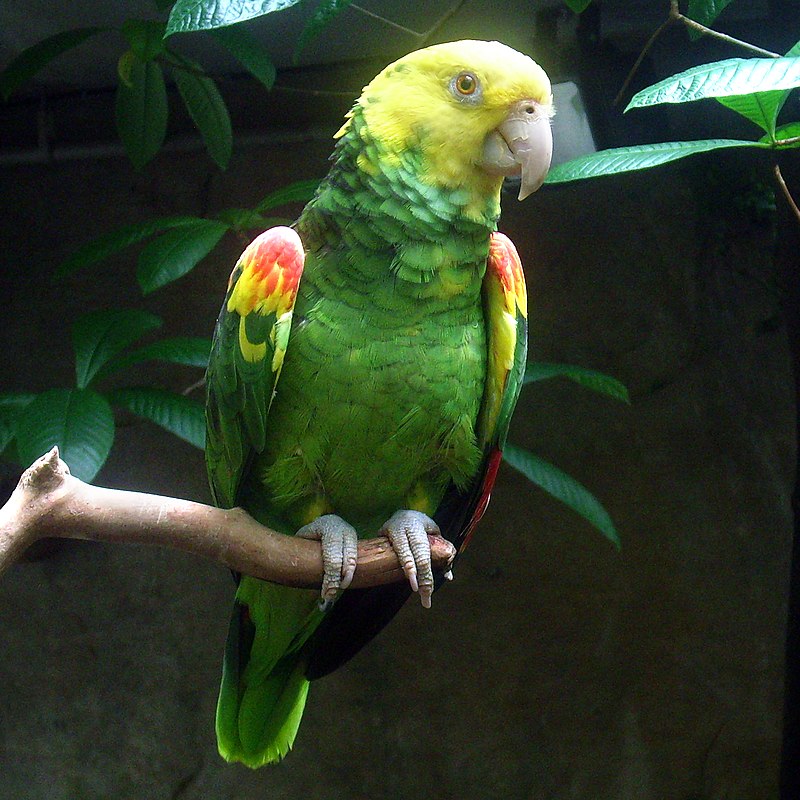
The Yellow-headed Amazon is an endangered species of parrot native to Mexico and northern Central America. It has a stocky, short-tailed body with bright green feathers and a distinct yellow head.
This bird prefers living in mangrove forests or near rivers or other bodies of water, as it requires plenty of moisture for its survival.
The Yellow-headed Amazon can measure between 15” – 17” (38 cm – 43 cm) from beak to tail, making them the largest member of their genus found in the New World.
They are social birds that live together in flocks year round; however they become more dispersed during breeding season when males will often form pairs with females nearby but away from the main flock.
Unfortunately due to habitat loss deforestation this species faces increasing threats and thus needs our help if we want them around for future generations.Scientific classification:
| Kingdom | Animalia |
| Phylum | Chordata |
| Class | Aves |
| Order | Psittaciformes |
| Family | Psittacidae |
| Genus | Amazona |
| Species | A. oratrix |
Also Featured In: Belize Birds, Case Birds that Live in with Us
19. Great Crested Flycatcher
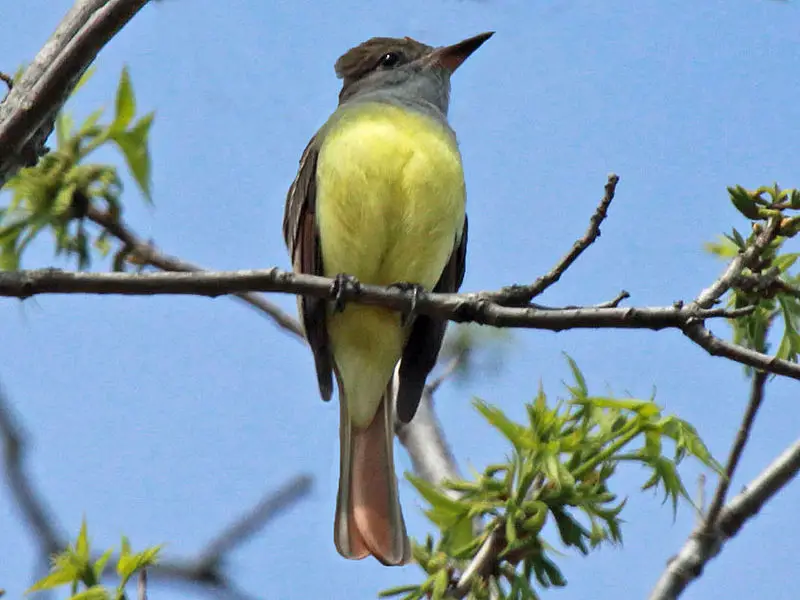
The Great crested flycatcher is a large insect-eating bird belonging to the tyrant flycatcher family.
It has an extensive range across North America, inhabiting most of the eastern and midwestern parts of the continent. They are usually found in treetops but rarely come down to ground level.
Adults measure around 7 inches long with wingspans up to 12 inches wide and they have grayish brown heads with yellow throats and upper breasts while their backs tend to be olive green or grey mixed with black spots on some species.
Their tails are broad, reaching lengths up 8 inches long, often being cocked when perched as they search for insects below them in trees or shrubs.
The males also possess a crest which adds even more splash of colour during mating season.Scientific classification:
| Kingdom | Animalia |
| Phylum | Chordata |
| Class | Aves |
| Order | Passeriformes |
| Family | Tyrannidae |
| Genus | Myiarchus |
| Species | M. crinitus |
Also Featured In: Flycatchers Species, Yellow Birds You’ll Find in Minnesota
20. Red-Crowned Amazon
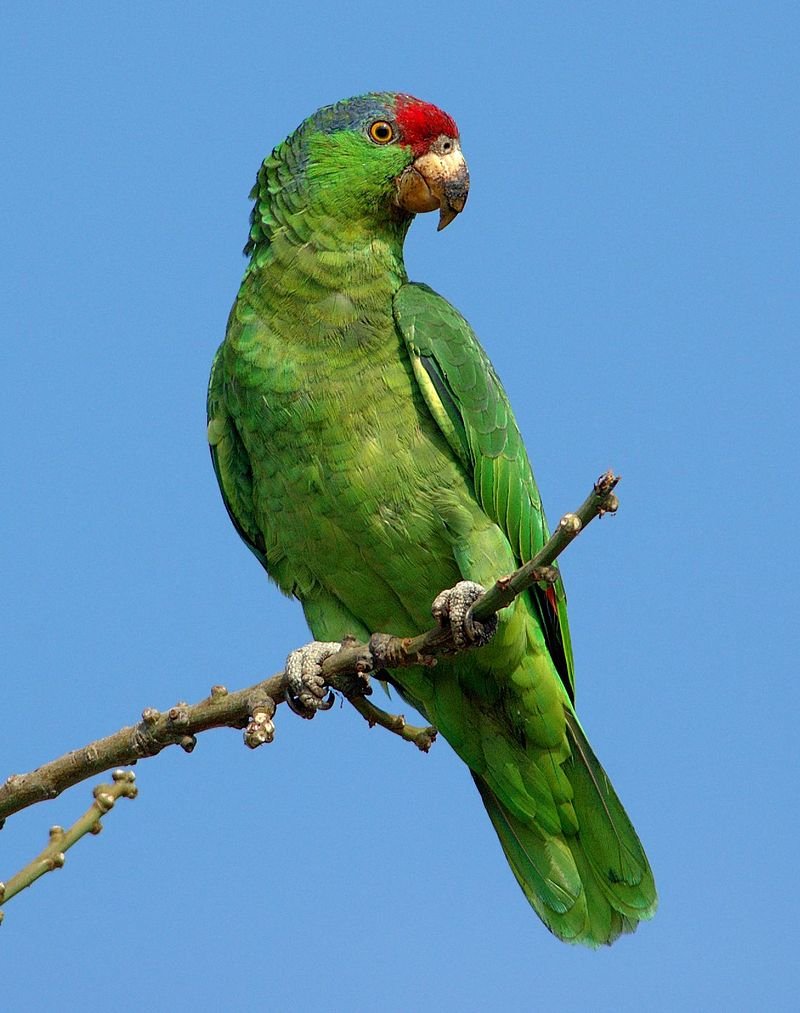
The Red-crowned Amazon is an endangered bird native to northeastern Mexico and possibly southern Texas. This parrot has a distinct red crown, green cheeks, and grayish wings with yellow highlights.
It typically lives in open woodlands near water sources such as rivers or lagoons. The estimated population of the wild stands between 2,000 – 4,300 mature individuals due to habitat destruction and illegal poaching for pet trade purposes.
Conservation efforts are being made by organizations like the IUCN Species Survival Commission Parrots Specialist Group (PSG) which works towards protecting this species from extinction through research projects along its range countries.Scientific classification:
| Kingdom | Animalia |
| Phylum | Chordata |
| Class | Aves |
| Order | Psittaciformes |
| Family | Psittacidae |
| Genus | Amazona |
| Species | A. viridigenalis |
Also Featured In: Parrots Species, Birds You’ll Find in the Rio Grande Valley
21. Green Parakeet
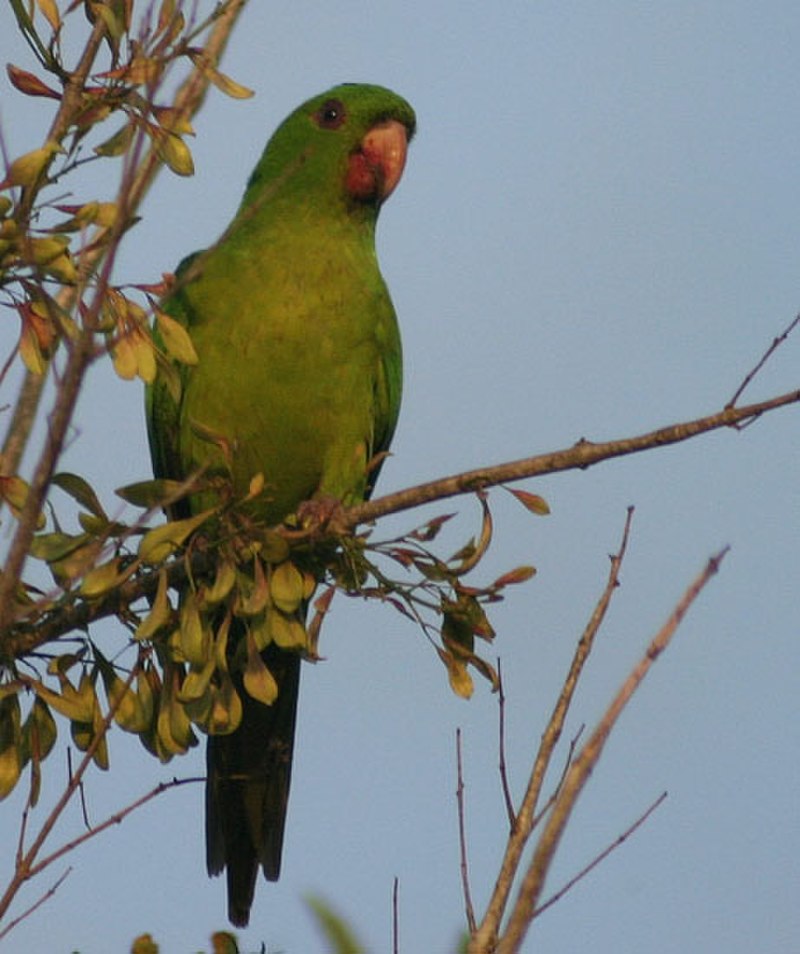
The green parakeet is a beautiful medium-sized bird, measuring up to 32 cm in length. It has distinctive bright green feathers and a yellow beak, making it truly stand out among other birds.
In the wild, these parrots primarily feed on seeds, various fruits and corn as well as live in scrubland or swampy areas across North and Central America stretching from Texas to Nicaragua.
Unfortunately they are sometimes considered crop pests due to their feeding habits.
Despite this behaviour however, the stunning colouration of these birds makes them an interesting addition to any landscape.Scientific classification:
| Kingdom | Animalia |
| Phylum | Chordata |
| Class | Aves |
| Order | Psittaciformes |
| Family | Psittacidae |
| Genus | Psittacara |
| Species | P. holochlorus |
Also Featured In: Birds You’ll Find in South Texas , Green Birds in That Live in Texas
22. Double-Crested Cormorant

The double-crested cormorant is a majestic bird with an impressive wingspan, found across North America from the Aleutian Islands all the way down to Mexico.
Its black plumage stands out against its bright orange-yellow facial skin and some extended patches of white feathers on each side of its throat.
It measures between 28 – 35 inches in length and has webbed feet that enable it to swim gracefully through rivers and lakes, as well as coastal areas.
These birds are known for their voracious appetite for fish, sometimes diving over 100 ft deep into water looking for food.
Despite this reputation they also feed on crustaceans, amphibians and insects when available.
Cormorants have been part of many cultures throughout history due to their remarkable ability to fly long distances making them valued messengers or companions during fishing expeditions at sea.Scientific classification:
| Kingdom | Animalia |
| Phylum | Chordata |
| Class | Aves |
| Order | Suliformes |
| Family | Phalacrocoracidae |
| Genus | Nannopterum |
| Species | N. auritum |
Also Featured In: Cormorant Species, Water Birds Live around Us
23. Painted Bunting
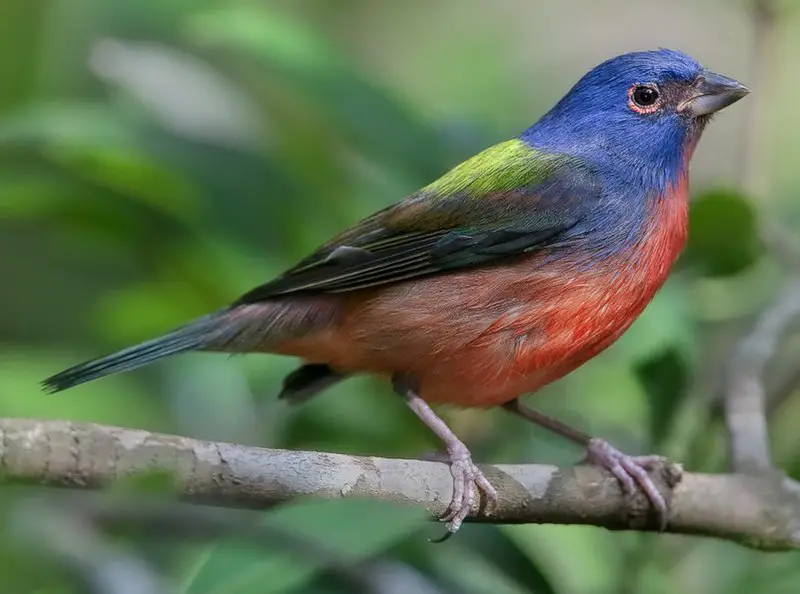
The Painted Bunting is an eye-catching bird from the Cardinal family, native to North America. It was first described by Carl Linnaeus in his eighteenth-century Systema Naturae.
The males of this species are particularly striking; they have brightly coloured plumage which only appears after their second year of life and can be distinguished from female birds through close inspection.
These colourful songbirds are a delight for any avid birder, with their vibrant hues bringing joy to nature lovers everywhere.
They often inhabit woodland areas where there is plenty of seed and insects available for them to feed on – as well as some shrubbery so that they can hide away safely when needed.Scientific classification:
| Kingdom | Animalia |
| Phylum | Chordata |
| Class | Aves |
| Order | Passeriformes |
| Family | Cardinalidae |
| Genus | Passerina |
| Species | P. ciris |
Also Featured In: Texas Birds, Flocks Birds around Us
24. American Purple Gallinule
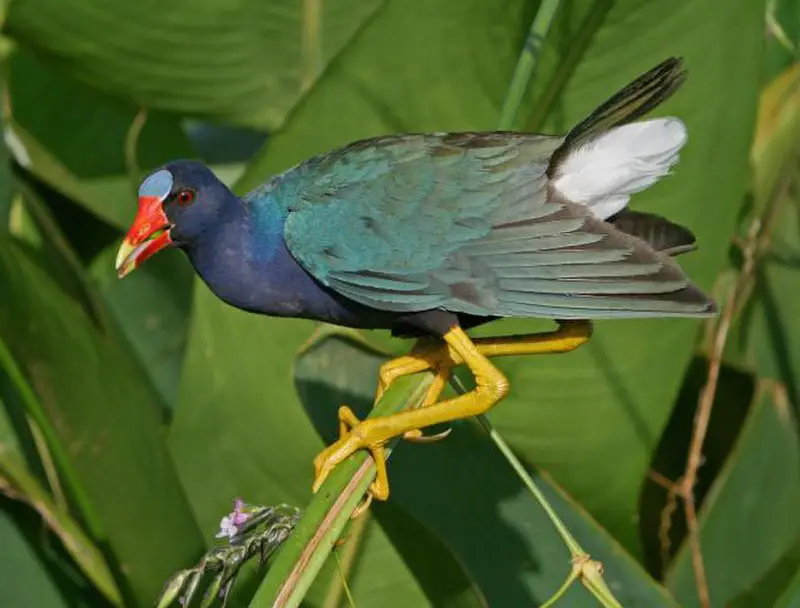
The American purple gallinule is a stunning bird found in North and South America. This species belongs to the order Gruiformes, which contains cranes, rails and crakes.
The family Rallidae classifies it as a rail species with its scientific name being Porphyrio martinica.
It is also known locally as the yellow-legged gallinule due to its striking plumage of greenish blue feathers on wings, back and tail along with bright red legs and bill.
Its environment includes freshwater marshes, swamps or paddy fields where these birds feed mostly on plants like water lilies or small invertebrates such as insects or molluscs.
These beautiful creatures are threatened by habitat destruction especially for agricultural purposes but conservation efforts are helping them survive despite this threat.Scientific classification:
| Kingdom | Animalia |
| Phylum | Chordata |
| Class | Aves |
| Order | Gruiformes |
| Family | Rallidae |
| Genus | Porphyrio |
| Species | P. martinicus |
Also Featured In: Florida Birds, Blue Birds You’ll Found around Us
25. Wilson’s Warbler
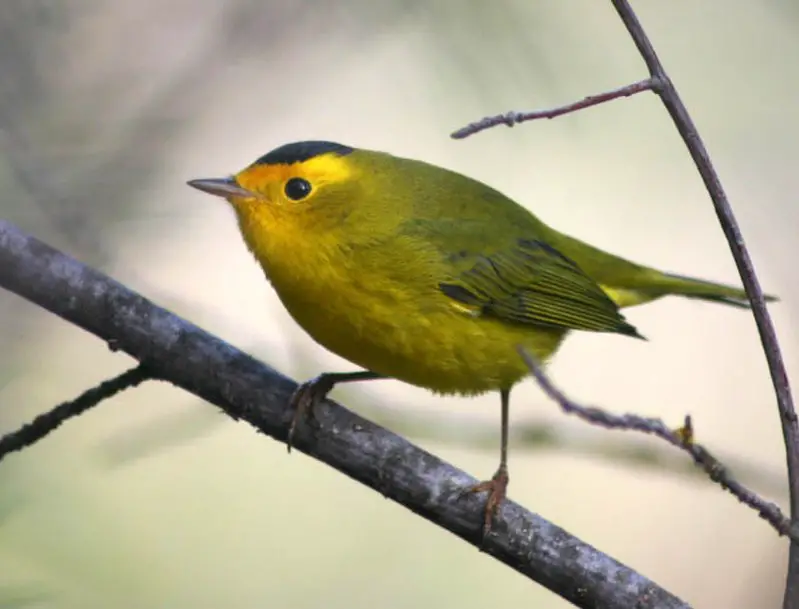
Wilson’s warbler is a small, brightly coloured bird found across North America. It has greenish upperparts and yellow underparts, with rounded wings and a long tail.
The male has an easily identifiable black crown patch which may or may not be present in the female depending on the subspecies.
They breed from Canada down to central parts of Mexico and then winter south through much of Central America.
These birds are usually seen flitting around low vegetation as they search for insects to eat – their main food source.
Their cheerful song can often be heard during spring migration when they travel back up north to breed again after spending winter further south.Scientific classification:
| Kingdom | Animalia |
| Phylum | Chordata |
| Class | Aves |
| Order | Passeriformes |
| Family | Parulidae |
| Genus | Cardellina |
| Species | C. pusilla |
Also Featured In: Nebraska Birds, Common Birds in Saskatchewan
26. Red-Eyed Vireo
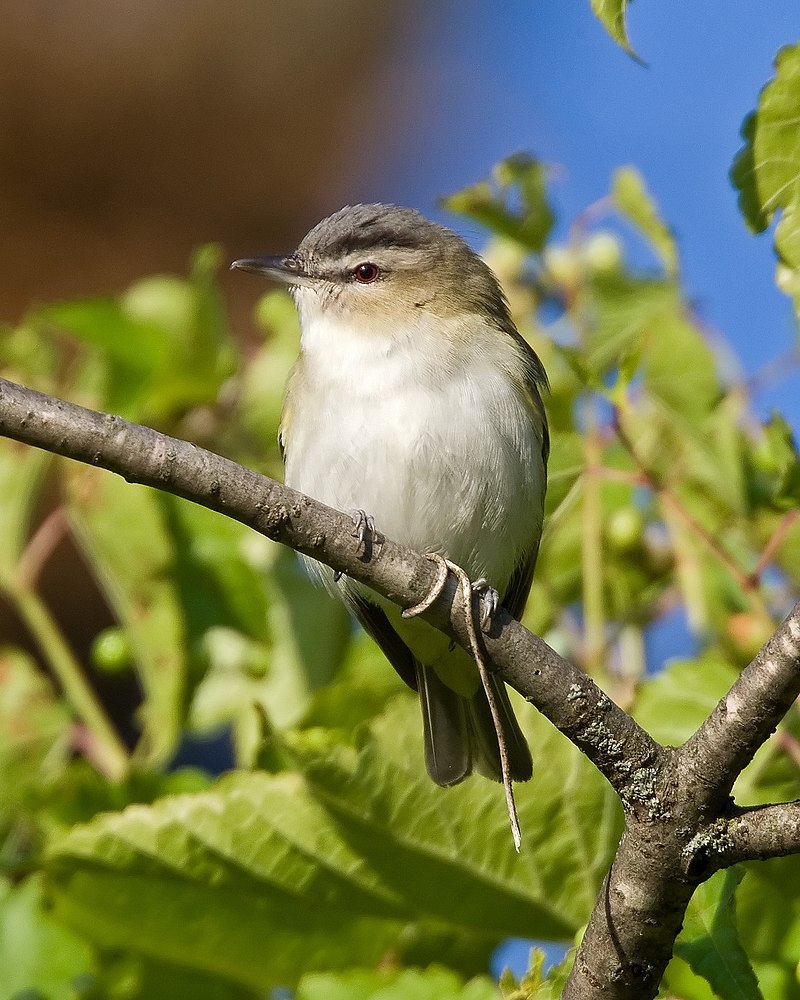
The Red-eyed Vireo is a small American songbird that resembles warblers, but its not closely related to them.
It has a vast range across North America and is considered fairly common throughout the region, with no notable threats resulting in it being classified as Least Concern on the IUCN’s red list.
Its name derives from Latin words meaning “green migratory bird”, most likely referring to female golden orioles or European greenfinches.
The species of vireos have striking plumage including bright yellow bellies and white stripes above their eyes which are surrounded by an orangey-red coloration – hence their namesake.Scientific classification:
| Kingdom | Animalia |
| Phylum | Chordata |
| Class | Aves |
| Order | Passeriformes |
| Family | Vireonidae |
| Genus | Vireo |
| Species | V. olivaceus |
Also Featured In: Maine Birds, New Hampshire Birds You Should Know
27. Black-Throated Green Warbler
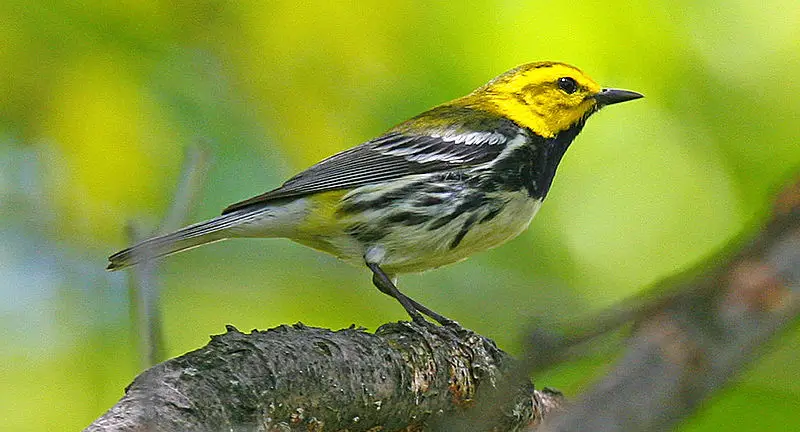
The Black-throated Green Warbler is a beautiful and dainty songbird in the New World warbler family.
It has an olive green crown, yellow face with dark markings, white wing bars and pale underparts streaked with black on the sides.
Adult males have a striking black throat and upper breast while females show paler coloration on their throats but retain some black patterning across their chest area.
They are quite small birds measuring around 14 cm in length from bill to tail tip that make them easy to miss if they aren’t singing.
Their diet consists mainly of insects which they catch by flitting through trees or shrubs as well as foraging among foliage making this species great help in controlling bug populations.Scientific classification:
| Kingdom | Animalia |
| Phylum | Chordata |
| Class | Aves |
| Order | Passeriformes |
| Family | Parulidae |
| Genus | Setophaga |
| Species | S. virens |
Also Featured In: Most Common Songs Birds that Live around You, Birds Commonly Found in New York
28. Mitred Parakeet
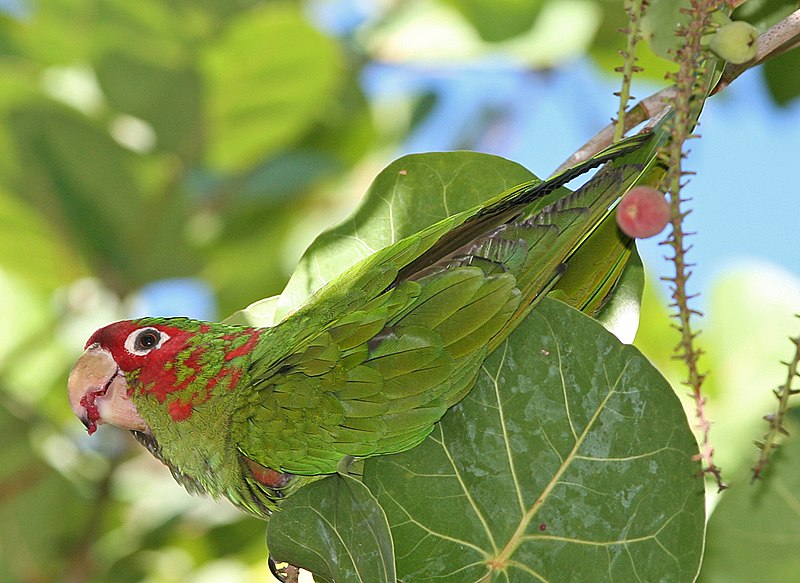
The Mitred Parakeet is a stunning species of parrot with its striking green and red plumage. It is native to the forests and woodlands in South America, ranging from Peru down to Argentina, as well as having introduced populations in California, Florida and Hawaii.
They are gregarious birds that usually inhabit small flocks or pairs while foraging for food on trees or shrubs.
These beautiful birds have unfortunately been declining due to habitat loss caused by deforestation; however they remain relatively common throughout much of their range.
In captivity these intelligent creatures can be easily trained using positive reinforcement techniques such as clicker training which will help them become more comfortable around humans.Scientific classification:
| Kingdom | Animalia |
| Phylum | Chordata |
| Class | Aves |
| Order | Psittaciformes |
| Family | Psittacidae |
| Genus | Psittacara |
| Species | P. mitratus |
Also Featured In: birds of green birds,
29. White-Winged Parakeet
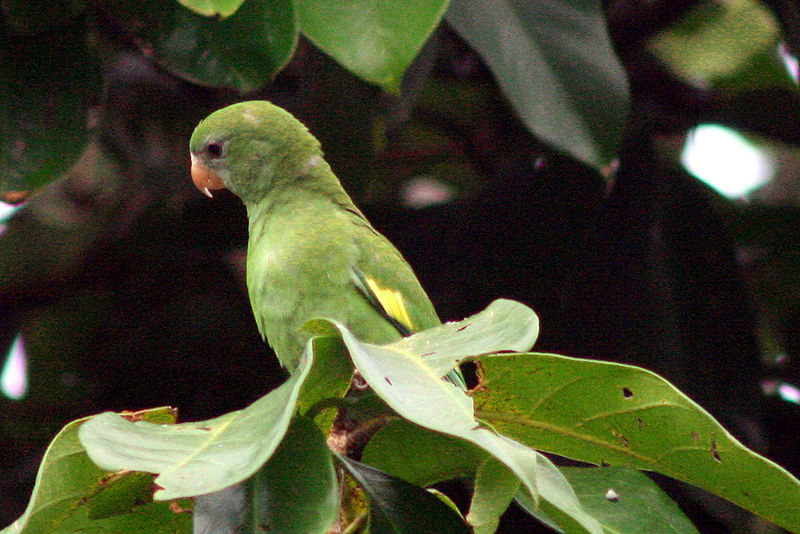
The White-winged parakeet is a beautiful bird native to the Amazon River basin. It has an exotic appearance, with its bright green body and yellow wings trimmed in white.
In addition to being kept as cage birds, they have been released into the wild where self-sustaining populations now exist in Lima, Peru; Los Angeles; Miami, Florida; and Puerto Rico.
These social creatures are known for their playful nature and raucous calls that echo through woodlands or suburban areas as flocks fly overhead.
They also make great pets due to their intelligence and affinity for human interaction – always ready for cuddles.Scientific classification:
| Kingdom | Animalia |
| Phylum | Chordata |
| Class | Aves |
| Order | Psittaciformes |
| Family | Psittacidae |
| Genus | Brotogeris |
| Species | B. versicolurus |
30. Yellow-Chevroned Parakeet
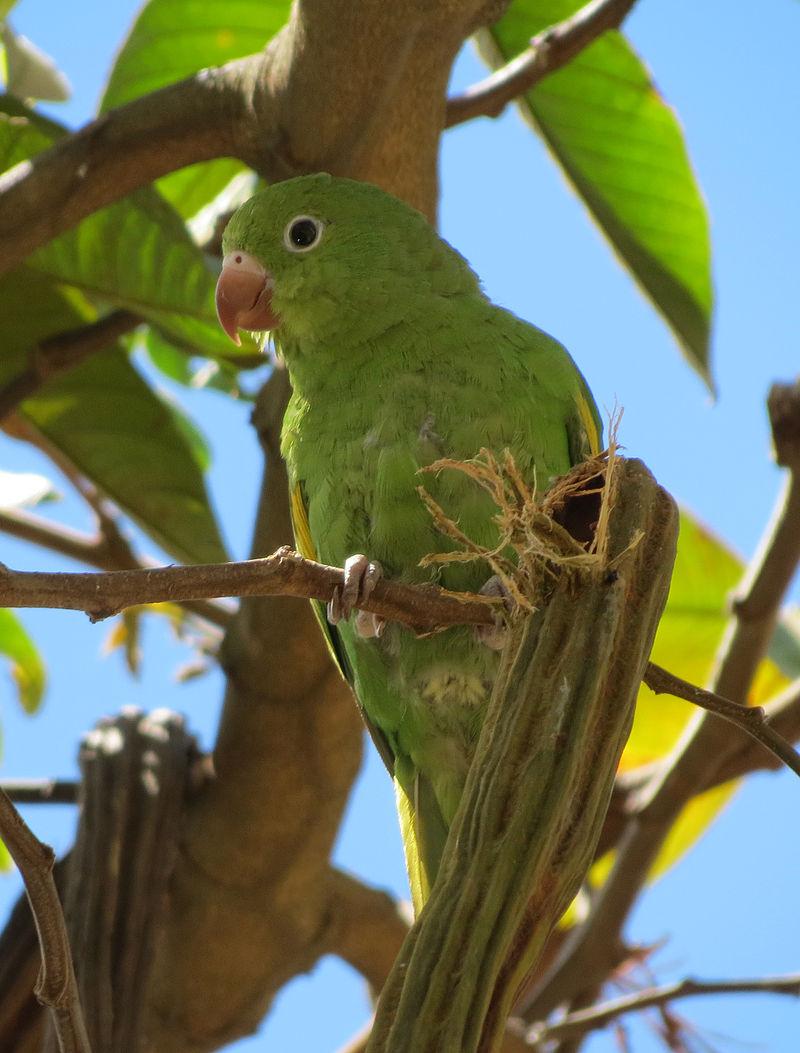
The Yellow-chevroned parakeet is a striking bird native to tropical South America, from central Brazil all the way down to northern Argentina. It has bright yellow and green plumage with distinctive chevrons around its neck and wings.
The Yellow-chevroned parakeet can be found in a variety of habitats including rain forest edges, palm groves, and grasslands.
Unfortunately, many have been released as pets into new areas where they are not naturally occurring such as Florida or California – but some of these populations have successfully established themselves.
This small yet resilient species is sure to capture your heart while out on an adventure exploring the wilds of South America.Scientific classification:
| Kingdom | Animalia |
| Phylum | Chordata |
| Class | Aves |
| Order | Psittaciformes |
| Family | Psittacidae |
| Genus | Brotogeris |
| Species | B. chiriri |
31. Nanday Parakeet
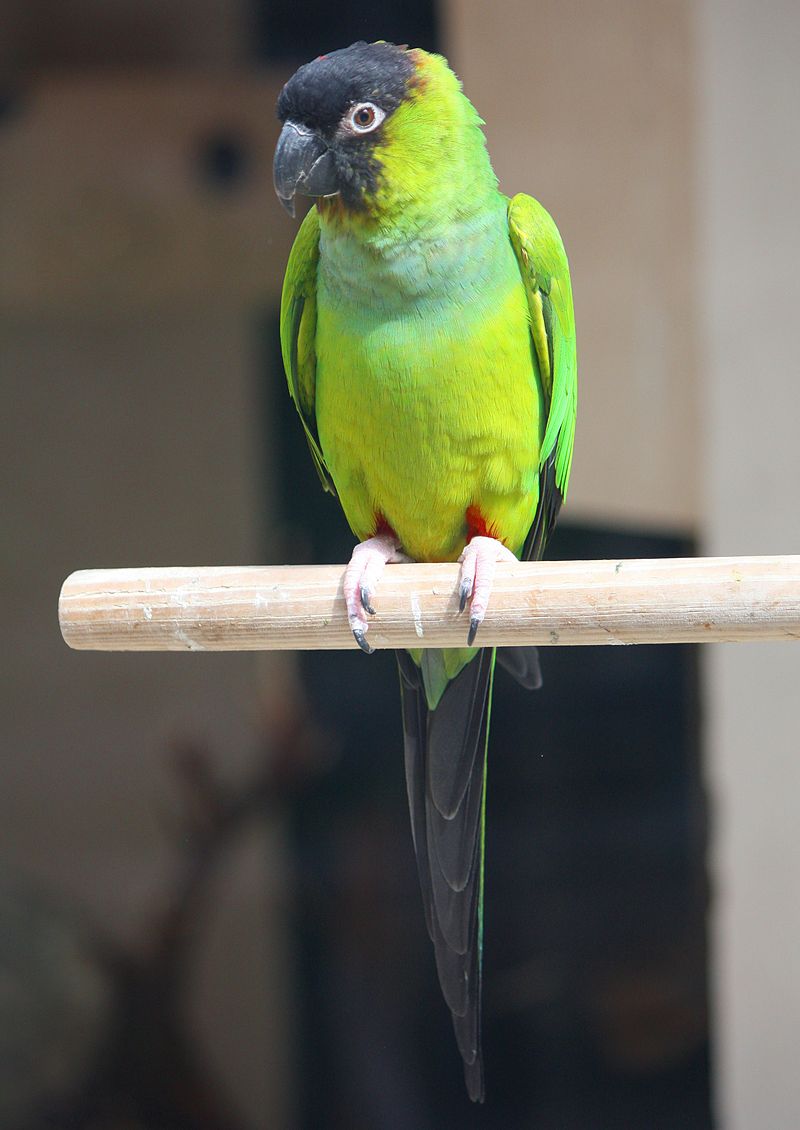
The Nanday Parakeet is a medium-small, mostly green Neotropical parrot native to South America. It has a distinctive black hood that covers its head and neck area.
This bird is known for its intelligence and playful nature which makes it an ideal pet in many homes.
Its diet consists of fruits, seeds, buds, flowers, nuts and occasionally insects making it easy to feed at home or outside the home environment.
The Nanday Parakeet can live up to 30 years with proper care so having one as a companion means you can enjoy their company for decades.
They are also very social birds who love interacting with people and other pets – perfect if you want some extra companionship in your life.Scientific classification:
| Kingdom | Animalia |
| Phylum | Chordata |
| Class | Aves |
| Order | Psittaciformes |
| Family | Psittacidae |
| Genus | Aratinga |
| Species | A. nenday |
32. Green-Winged Teal
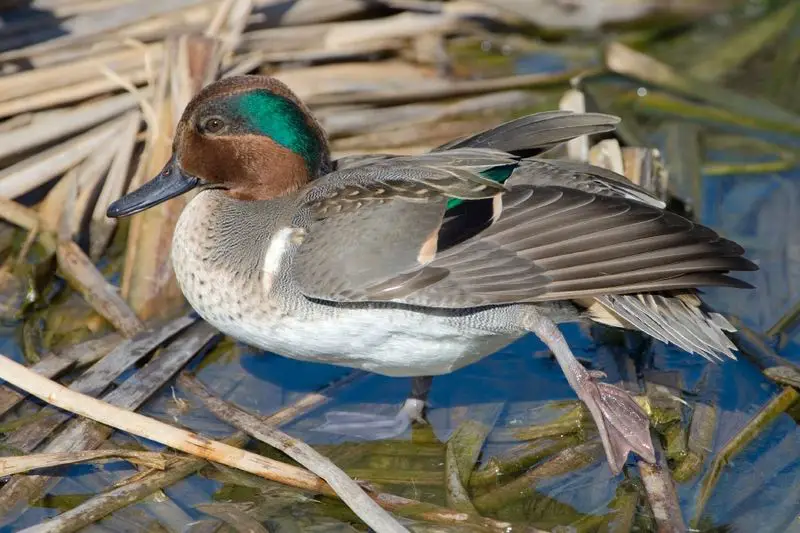
The green-winged teal is a common and widespread duck that can be found across most of North America, except for the Aleutian Islands.
It was once thought to belong to the same species as Eurasian teals but has since been classified differently by many authorities.
These small ducks have colorful wings which display shades of green and blue along with buffy brown coloration on their undersides.
The male birds are particularly striking during mating season when they acquire beautiful chestnut markings on their heads and upper breasts.
They feed mainly in shallow water bodies such as ponds, lakes, marshes or estuaries, eating aquatic invertebrates like snails or insects.
When disturbed they can fly away rapidly with a loud whistling sound produced by their wings during flight.Scientific classification:
| Kingdom | Animalia |
| Phylum | Chordata |
| Class | Aves |
| Order | Anseriformes |
| Family | Anatidae |
| Genus | Anas |
| Species | A. carolinensis |
Also Featured In: Phoenix Birds You Should Know, Wetlands Birds You Should Know
33. Ovenbird
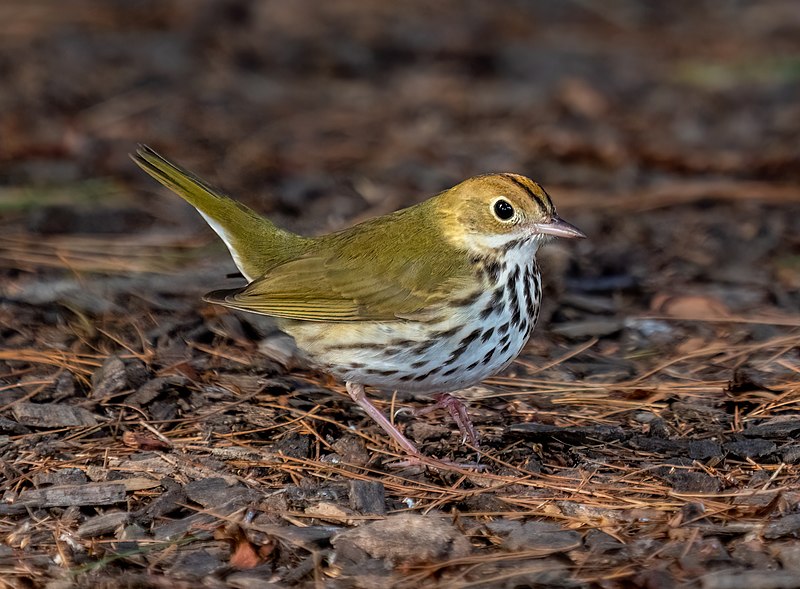
The ovenbird is a migratory songbird found in eastern North America. It winters in Central America, many Caribbean islands, Florida, and northern Venezuela.
This bird belongs to the New World warbler family known as Parulidae. Surprisingly, the ovenbird is the only species in the genus Seiurus. Genetic analysis shows this bird is distinct from all other species of its family.Scientific classification:
| Kingdom | Animalia |
| Phylum | Chordata |
| Class | Aves |
| Order | Passeriformes |
| Family | Parulidae |
| Genus | Seiurus Swainson, 1827 |
| Species | S. aurocapilla |
Also Featured In: Birds of Nova Scotia, Adirondack Mountain Birds